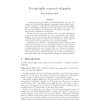226 search results - page 15 / 46 » Lower bounds on the obstacle number of graphs |
CORR
2010
Springer
13 years 5 months ago
2010
Springer
We generalize the notions of flippable and simultaneously-flippable edges in a triangulation of a set S of points in the plane, into so called pseudo simultaneously-flippable edge...
PAAPP
2000
13 years 7 months ago
2000
Minimizing the amount of time and number of processors needed to perform an application reduces the application's fabrication cost and operation costs. A directed acyclic gra...
JGT
2007
13 years 7 months ago
2007
A well-known theorem of Mader [5] states that highly connected subgraphs can be forced in finite graphs by assuming a high minimum degree. Solving a problem of Diestel [2], we ex...
INFOCOM
2005
IEEE
14 years 1 months ago
2005
IEEE
Abstract— Given a wireless ad hoc network and an endto-end traffic pattern, the power rate function refers to the minimum total power required to support different throughput un...
IPTPS
2003
Springer
14 years 1 months ago
2003
Springer
Koorde1 is a new distributed hash table (DHT) based on Chord [15] and the de Bruijn graphs [2]. While inheriting the simplicity of Chord, Koorde meets various lower bounds, such a...

